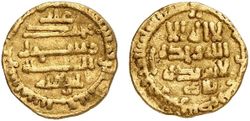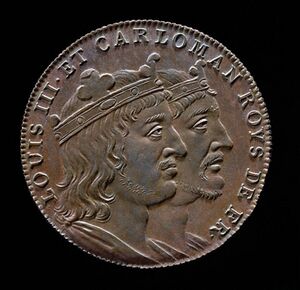879
► | قرن 8 | << قرن 9 >> | قرن 10 | ◄
► | عقد 840 | عقد 850 | عقد 860 | << عقد 870 >> | عقد 880 | عقد 890 | عقد 900 | ◄
► | ► | 874 | 875 | 876 | 877 | 878 | << 879 >> | 880 | 881 | 882 | 883 | 884 | ◄ | ◄
تحويل 1-1-879م الى هجري (وصلة خارجية) | تحويل 31-12-879م الى هجري (وصلة خارجية) | ابحث في الموسوعة عن مواضيع متعلقة بسنة 879
| ألفية: | الألفية 1 |
|---|---|
| قرون: | القرن 8 – القرن 9 – القرن 10 |
| عقود: | عقد 840 عقد 850 عقد 860 – عقد 870 – عقد 880 عقد 890 عقد 900 |
| سنين: | 876 877 878 – 879 – 880 881 882 |
| 879 حسب الموضوع | |
| السياسة | |
| زعماء الدول – الدول ذات السيادة | |
| تصنيفات المواليد والوفيات | |
| المواليد – الوفيات | |
| تصنيفات التأسيسات والانحلالات | |
| تأسيسات – انحلالات | |
| التقويم الگريگوري | 879 DCCCLXXIX |
| آب أوربه كونديتا | 1632 |
| التقويم الأرمني | 328 ԹՎ ՅԻԸ |
| التقويم الآشوري | 5629 |
| التقويم البهائي | −965 – −964 |
| التقويم البنغالي | 286 |
| التقويم الأمازيغي | 1829 |
| سنة العهد الإنگليزي | N/A |
| التقويم البوذي | 1423 |
| التقويم البورمي | 241 |
| التقويم البيزنطي | 6387–6388 |
| التقويم الصيني | 戊戌年 (التراب الكلب) 3575 أو 3515 — إلى — 己亥年 (التراب الخنزير) 3576 أو 3516 |
| التقويم القبطي | 595–596 |
| التقويم الديسكوردي | 2045 |
| التقويم الإثيوپي | 871–872 |
| التقويم العبري | 4639–4640 |
| التقاويم الهندوسية | |
| - ڤيكرام سامڤات | 935–936 |
| - شاكا سامڤات | 801–802 |
| - كالي يوگا | 3980–3981 |
| تقويم الهولوسين | 10879 |
| تقويم الإگبو | −121 – −120 |
| التقويم الإيراني | 257–258 |
| التقويم الهجري | 265–266 |
| التقويم الياباني | Gangyō 3 (元慶3年) |
| تقويم جوچى | N/A |
| التقويم اليوليوسي | 879 DCCCLXXIX |
| التقويم الكوري | 3212 |
| تقويم مينگوو | 1033 قبل جمهورية الصين 民前1033年 |
| التقويم الشمسي التايلندي | 1422 |
Year 879 (DCCCLXXIX) was a common year starting on Thursday of the Julian calendar.
أحداث
By place
Europe
- April 10 – King Louis the Stammerer dies at Compiègne, after a reign of 18 months. He is succeeded by his two sons, Louis III and Carloman II. They are crowned at Ferrières Abbey, and rule the West Frankish Kingdom together as joint-kings.
- Baldwin I ("Iron Arm") dies, after 15 years as margrave of Flanders. He is buried in the Abbey of Saint Bertin (near Saint-Omer), and is succeeded by his son Baldwin II.
- Oleg, brother-in-law of the Varangian ruler Rurik, is entrusted to take care of his kingdom Novgorod after his death. He becomes regent of his son Igor.
- King Charles the Fat becomes ruler of the Kingdom of Italy, after the abdication of his brother Carloman of Bavaria, who has been incapacitated by a stroke.
Britain
- King Alfred the Great establishes a series of fortified villages (or burhs) to protect Wessex against Viking raids. He creates a standing army to defend the strategic ports, and builds a network of well-maintained army roads (known as herepaths).
- Viking leader Guthrum becomes 'king' of East Anglia. A Viking fleet sails up the River Thames, and builds a camp at Fulham (near London) to prepare for an invasion of France.
Arabian Empire
- Zanj Rebellion: The Abbasid Caliphate concentrates its efforts against the Zanj rebels in Mesopotamia. The Abbasid general Al-Mu'tadid leads an expeditionary force (10,000 men) to suppress the revolt. This marks the turning-point of the war.[1]
Asia
- Guangzhou Massacre: The Chinese rebel leader Huang Chao besieges the seaport in Guangzhou, and slaughters many of its inhabitants and foreign merchants. According to sources, the death toll ranges from 120,000 to 200,000 foreigners.[2][3]
By topic
Religion
- Fourth Council of Constantinople: Emperor Basil I calls for a synod, and reinstates Photius I as patriarch of Constantinople.
- June 7 – Pope John VIII recognizes the Duchy of Croatia, under Duke (knyaz) Branimir, as an independent state.
- Wilfred the Hairy, count of Barcelona, founds the Benedictine monastery at Ripoll, in Catalonia (Spain).
مواليد
- September 17 – Charles the Simple, king of the West Frankish Kingdom (d. 929)
- October 19 – Yingtian, empress of the Khitan Liao Dynasty (d. 953)
وفيات
- April 10 – Louis the Stammerer, king of the West Frankish Kingdom (b. 846)
- April 18 – Seishi, empress of Japan (b. 810)
- June 5 – Ya'qub ibn al-Layth, founder of the Saffarid Dynasty (b. 840)
- Abi'l-Saj Devdad, Sogdian prince
- Áed Findliath, high king of Ireland
- Ahmad ibn al-Khasib al-Jarjara'i, Muslim vizier
- Ansegisus, archbishop of Sens (or 883)
- Baldwin I, margrave of Flanders
- Ceolwulf II, king of Mercia (approximate date)
- Cormac mac Ciaran, Irish abbot
- Gebhard, Frankish nobleman
- Gérard II, Frankish nobleman (or 877)
- Hincmar, Frankish bishop
- Landulf II, bishop and count of Capua
- Li Wei, chancellor of the Tang Dynasty
- Rurik, prince of Novgorod
- Sulayman ibn Abdallah, Muslim governor
- Suppo II, duke of Spoleto (approximate date)
- Zdeslav, duke (knyaz) of Croatia
References
- ^ Kennedy, Hugh N. (2001). The Armies of the Caliphs: Military and Society in the Early Islamic State. London and New York: Routledge. pp. 153-154. ISBN 0-415-25093-5.
- ^ Laet, Sigfried J. de (1994). History of Humanity: From the seventh to the sixteenth century (Illustrated ed.). UNESCO. ISBN 978-92-3-102813-7.
- ^ Lipman, Jonathan N. (1997). Familiar Strangers: A History of Muslims in Northwest China (Illustrated ed.). University of Washington Press. ISBN 978-0-295-97644-0.
All content in this article is created by Marefa contributors and is © Marefa. All rights reserved.

